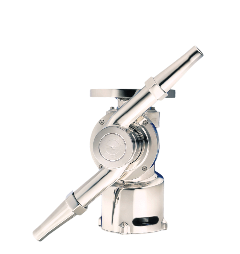High powered tank cleaning for storm tanks

The cleaning of stormwater attenuation tanks requires a robust and vigorous washing jet. The StormBlaster™ rotary jet head was designed to clean oil tankers and other cargo ships. It has since been re-engineered to meet the specific needs of the water and sewage industry.
These robust rotary solid stream tank washers deliver two high impact spray jets that will clean the toughest residues. The spray head rotates in two dimensions and so over time will build up a complete cleaning pattern that ensures that every inch of the target surface is thoroughly cleaned.
Main features
Sealed gearbox
The sealed gearbox ensures that none of the cleaning fluid comes into contact with the gears meaning the StormBlaster can use fluids with a high particle content as the cleaning medium. In practical terms this means final effluent or river water can be used as the cleaning fluid eliminating the need for a potable water supply.
Powerful two jet system
Typically StormBlasters will be configured with only two jets. This maximises the jet length achieved for any given flow rate. The sacrifice made for having only two cleaning jets is that the overall time required to complete the cleaning cycle is higher. Cleaning cycles will vary between 20 and 60 minutes depending on the pressure used and nozzle sizes. For storm tank cleaning these longer cycle times are typically unimportant as there is generally no benefit from having a 10 minute clean cycle.
180 degree down configuration
Even with covered storm tanks we generally recommend a 180 degree downwards wash system. The tank roof is very unlikely to build up any residue and so cleaning it is simply a waste of water. By focusing the cleaning only downwards most of the cleaning fluid ends up being directed where most of the residue builds up i.e. in the bottom of the storm tank.
Extremely rugged design
The StormBlaster tank cleaning system was originally designed to be deployed in oil tankers and other sea-going vessels. These units would remain in a marine environment potentially for months at a time, only to be used once the tanker needed cleaning between loads. As such every part of these machines is designed to be highly robust. This is particularly important when deploying in open storm tanks as the unit will be exposed to the elements.
Special features
The following features have been re-engineered specifically for the storm tank cleaning market
Sub 180 degree down pattern
Option of lower than 180 degree cleaning. In some open tanks the StormBlasters need to be positioned slightly above the top of the storm tank meaning a true 180 degree down machine might cause jets to exit the tank. If this there is a risk of this occurring the StormBlaster can be configured to give a 170 or 160 degree clean instead.
Downward exhaust ports
Downwards only exhaust port. In the original ship cleaning design the exhaust ports on the machine would spray in all directions. This has been changed on the StormBlaster to ensure all fluid is directed downwards only and back into the tank. This feature reduces the risk of bio aerosols being generated by exhaust fluid.